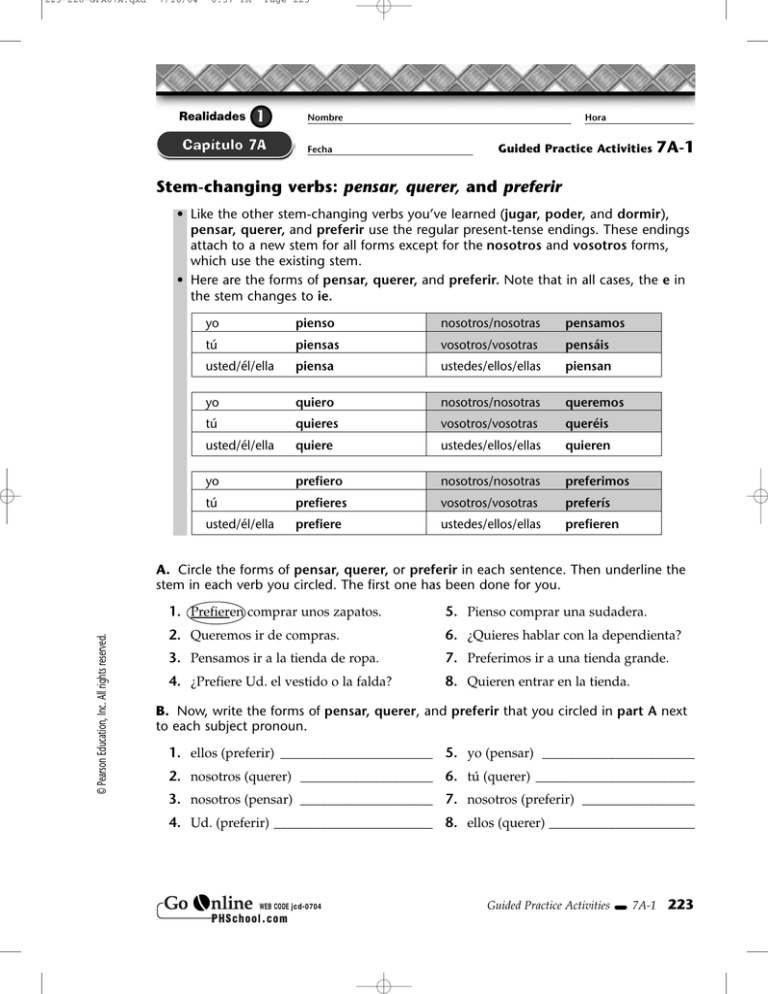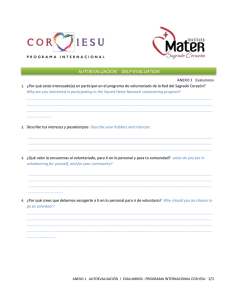Stem-changing verbs: pensar, querer, and preferir
Anuncio

223-228-GPA07A.qxd 7/16/04 6:57 PM Page 223 Realidades Nombre Capítulo 7A Fecha Hora Guided Practice Activities 7A-1 Stem-changing verbs: pensar, querer, and preferir • Like the other stem-changing verbs you’ve learned (jugar, poder, and dormir), pensar, querer, and preferir use the regular present-tense endings. These endings attach to a new stem for all forms except for the nosotros and vosotros forms, which use the existing stem. • Here are the forms of pensar, querer, and preferir. Note that in all cases, the e in the stem changes to ie. yo pienso nosotros/nosotras pensamos tú piensas vosotros/vosotras pensáis usted/él/ella piensa ustedes/ellos/ellas piensan yo quiero nosotros/nosotras queremos tú quieres vosotros/vosotras queréis usted/él/ella quiere ustedes/ellos/ellas quieren yo prefiero nosotros/nosotras preferimos tú prefieres vosotros/vosotras preferís usted/él/ella prefiere ustedes/ellos/ellas prefieren © Pearson Education, Inc. All rights reserved. A. Circle the forms of pensar, querer, or preferir in each sentence. Then underline the stem in each verb you circled. The first one has been done for you. 1. Prefieren comprar unos zapatos. 5. Pienso comprar una sudadera. 2. Queremos ir de compras. 6. ¿Quieres hablar con la dependienta? 3. Pensamos ir a la tienda de ropa. 7. Preferimos ir a una tienda grande. 4. ¿Prefiere Ud. el vestido o la falda? 8. Quieren entrar en la tienda. B. Now, write the forms of pensar, querer, and preferir that you circled in part A next to each subject pronoun. 1. ellos (preferir) _______________________ 5. yo (pensar) _______________________ 2. nosotros (querer) ____________________ 6. tú (querer) ________________________ 3. nosotros (pensar) ____________________ 7. nosotros (preferir) _________________ 4. Ud. (preferir) ________________________ 8. ellos (querer) ______________________ WEB CODE jcd- 0704 Guided Practice Activities 7A-1 223 223-228-GPA07A.qxd 7/16/04 Realidades Capítulo 7A 6:57 PM Page 224 Nombre Hora Guided Practice Activities Fecha 7A-2 Stem-changing verbs (continued) C. Circle the correct form of pensar, querer, or preferir to complete each sentence. 1. Yo ( quiere / quiero ) comprar unas botas nuevas. 2. Ella ( prefiere / prefieren ) los pantalones cortos a la falda. 3. Nosotros ( prefieren / preferimos ) ir de compras en una tienda grande. 4. Ellos ( pienso / piensan ) comprar dos abrigos nuevos. 5. Tú y yo ( pensamos / piensas ) buscar una tienda con precios buenos. 6. Ustedes ( quieres / quieren ) hablar con la dependienta. 7. Nosotros ( queremos / quieres ) entrar en la tienda de ropa. 8. Tú y yo no ( piensan / pensamos ) comprar ropa hoy. D. Complete the sentences with forms of pensar, querer, or preferir. Follow the models. Modelos Tú (pensar) comprar un suéter. Tú piensas comprar un suéter. Tú y yo (preferir) comprar el vestido azul. Tú y yo preferimos comprar el vestido azul. 1. Elena (pensar) comprar una sudadera. Elena _______________________ comprar una sudadera. 2. Sandra y yo (querer) ir a una tienda de ropa grande. Sandra y yo _______________________ ir a una tienda de ropa grande. 3. Yo (preferir) hablar con un dependiente. © Pearson Education, Inc. All rights reserved. Yo _______________________ hablar con un dependiente. 4. Nosotras (pensar) que es un precio bueno. Nosotras _______________________ que es un precio bueno. 5. Tú (querer) entrar en una tienda de ropa grande. Tú _______________________ entrar en una tienda de ropa grande. 6. Tú y yo (querer) comprar unas camisetas nuevas. Tú y yo _______________________ comprar unas camisetas nuevas. 7. Tomás y Sebastián (preferir) no comprar ropa hoy. Tomás y Sebastián _______________________ no comprar ropa hoy. 8. Yo (pensar) comprar una gorra y un suéter. Yo _______________________ comprar una gorra y un suéter. 224 Guided Practice Activities 7A-2 WEB CODE jcd- 0704 223-228-GPA07A.qxd 7/16/04 6:57 PM Page 225 Realidades Nombre Capítulo 7A Hora Guided Practice Activities Fecha 7A-3 Demonstrative adjectives • Demonstrative adjectives are the equivalent of this, that, these, and those in English. You use them to point out nouns: this hat, those shoes. • In Spanish, the demonstrative adjectives agree with the noun they accompany in both gender and number. Close Farther away Singular masculine este suéter (this sweater) ese suéter (that sweater) Singular feminine esta falda (this skirt) esa falda (that skirt) Plural masculine estos suéteres (these sweaters) esos suéteres (those sweaters) Plural feminine estas faldas esas faldas (these skirts) (those skirts) A. Circle the demonstrative adjective in each sentence below. Write C next to the sentence if the object referred to is close (este, esta, estos, estas). Write F if the object referred to is farther away (ese, esa, esos, esas). 1. Me gustan estos zapatos. ______ 2. Quiero comprar esas camisetas. ______ 3. ¿Prefieres esta falda? ______ 4. Esa camisa es muy bonita. ______ 5. No me gustan esos vestidos. ______ 6. ¿Te gustan estas chaquetas? ______ © Pearson Education, Inc. All rights reserved. B. Circle the correct demonstrative adjective in each sentence. 1. ¿Cómo me quedan ( esto / estos ) pantalones? 2. Me gustan ( esas / esos ) sudaderas. 3. ¿Prefieres ( esta / este ) chaqueta? 4. Pienso comprar ( estos / este ) calcetines. 5. No me gusta ( ese / esa ) abrigo. 6. ¿Cómo me queda ( este / esta ) traje? 7. ( Eso / Esas ) botas son muy bonitas. 8. ¿Vas a comprar ( esos / esas ) pantalones cortos? WEB CODE jcd- 0703 Guided Practice Activities 7A-3 225 223-228-GPA07A.qxd 7/16/04 6:57 PM Page 227 Realidades Nombre Capítulo 7A Fecha Hora Guided Practice Activities 7A-5 Lectura: Tradiciones de la ropa panameña A. You will find out a lot about the contents of the reading in your textbook by looking at the title and the photos. In the spaces below, write three main topics that you would expect a reading on Panamanian culture to cover. 1. ____________________________________________________________________________ 2. ____________________________________________________________________________ 3. ____________________________________________________________________________ B. Read the paragraph below on polleras and answer the questions that follow in Spanish. Una tradición panameña de mucho orgullo (pride) es llevar el vestido típico de las mujeres, ≈la pollera∆. Hay dos tipos de pollera, la pollera montuna y la pollera de gala, que se lleva en los festivales. 1. Según la lectura, ¿cómo se llama el vestido típico de las mujeres en Panamá? ____________________________________________________________________________ 2. ¿Cuáles son los dos tipos de pollera? _________________________________ y _______________________________________ 3. ¿Cuándo se lleva la pollera de gala? ___________________________________________ © Pearson Education, Inc. All rights reserved. C. Look through the reading in your textbook again to find whether the following statements are true or false. Then, circle cierto for true or falso for false. 1. cierto falso Hay un Día Nacional de la Pollera en la ciudad de Las Tablas. 2. cierto falso Las Tablas es famosa por ser el mejor lugar para celebrar los carnavales. 3. cierto falso El canal de Panamá conecta el océano Pacífico con el lago Titicaca. 4. cierto falso Panamá es un istmo. 5. cierto falso El segundo tipo de ropa auténtico de Panamá que se menciona es la gorra de Panamá. WEB CODE jcd- 0705 Guided Practice Activities 7A-5 227 223-228-GPA07A.qxd 7/16/04 6:57 PM Realidades Capítulo 7A Page 228 Nombre Hora Guided Practice Activities Fecha 7A-6 Presentación oral Task: You and a partner will play the roles of a customer and a salesclerk. The customer will look at various items in the store, talk with the clerk and then decide if he or she would like to buy anything. A. Work with a partner to prepare the skit. You will be the customer. You and your partner will need to discuss what type of clothing your store is selling. You will then need a name for your store and some samples of merchandise to use in your skit. You may bring in clothes or use cutouts from a magazine. Complete the following in the spaces below: Type of clothing: ____________________________________________________________ Store name: _________________________________________________________________ B. Now, make a list below of five different expressions and questions that will help you play your role. You may want to look back in the A primera vista and Videohistoria sections in your textbook for ideas to help you get started. 1. ____________________________________________________________________________ 2. ____________________________________________________________________________ 3. ____________________________________________________________________________ 4. ____________________________________________________________________________ 5. ____________________________________________________________________________ C. Work with your partner to put together and practice your presentation. Keep in mind the following things: ______ to speak clearly ______ to keep the conversation going ______ to finish the conversation at a logical point D. When you present your skit, the clerk will begin the conversation. That means that you will need to respond as your first action. As your last action, you will need to decide whether or not to buy something. Your teacher will grade you based on the following: • how well you keep the conversation going • how complete your presentation is • how well you use new and previously learned vocabulary 228 Guided Practice Activities 7A-6 © Pearson Education, Inc. All rights reserved. ______ to answer questions using complete sentences
